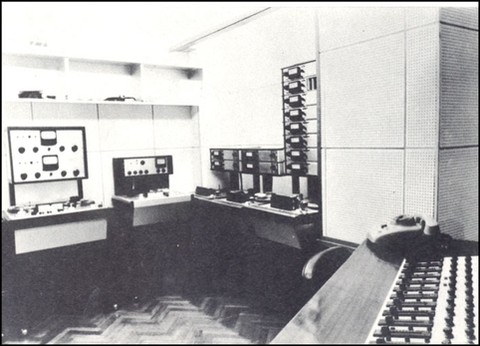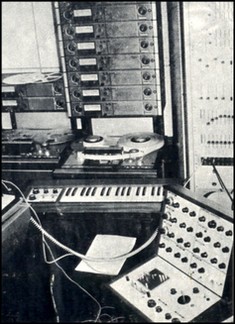Piero Umiliani - The Official Website - International Version
Main menu:
Sound Work Shop
Music, Maestro! > Library Music
SOUND WORK SHOP
The history of Omicron and of the other independent labels begins a long time ago, when the Maestro, 18 at the time, tries to find a publisher for his compositions. He does not find anybody willing to believe in his music so, in order to safeguard his music copyrights, he asks his mother Eleonora to establish the Omega label.
Twenty years later, having achieved his success, he finally decides to have his own label and a recording studio where he can experiment with new instruments and also record soundtracks. In 1964 he establishes the Omicron editions and label, named after the other letter “o” of the Greek alphabet, in memory of the previous edition established by his mother. The first three albums of background music (about one hundred copies are printed of each record) are recorded in the RCA studios in Rome and Morandini studios in Milan. The first record, “Comica Finale”, includes themes in ragtime style employed in the sonorizations of Charlie Chaplin gags for Italian cinema (“Uno Contro Tutti” and “Il Pellegrino”). The second record, “Musica per Due”, is a collection of romantic themes in “night club” style, among which there is the famous “Chanel” also included by Oscar Peterson in his repertoire (see jazz section, chapter on “Collaborations”). The third is “Arie Antiche” featuring music with Renaissance and Medieval inspirations. The goal is to send these records to RAI TV and to the major national and international producers to be used as background music for TV programs, documentaries and so on. With time, sonorizations have become the business core of Umiliani’s labels, in addition to the release of jazz and soundtrack albums as documented in the other pages of this site.


At the beginning, Umiliani records his Omicron albums in external studios, mainly in the RCA studios, but a radical change occurs on 27 December 1968. Piero Umiliani and his wife Stefania purchase a place in the Trionfale district in Rome that, in a few months, becomes the Sound Work Shop recording studio.
With the opening of the recording studio he establishes new independent labels ( Liuto, SoundWorkShop, VideoVoice, Ciak, Telesound). Starting in 1969, Umiliani self-produces all his soundtracks in this studio, which he equips with the most advanced screening and editing systems. Umiliani purchases the first synthesizers from the US (moog, mellotron, synthi). Their sounds fill his sonorization records and today they have become a point of reference in the history of Italian electronic music. At the time, Umiliani aims for the national distribution of those legendary albums (“Switched on Naples”, “Synthi Time”, “Tra Scienza e Fantascienza”, “Mille e Una Sera”), but major companies consider them “inadequate” for the market, showing once again lack of vision.
PIERO UMILIANI aka ROVI, MOGGI, TUSCO, RUSCIGAN, ZALLA, CATAMO...

Umiliani is not upset by these rejections and releases up to twelve records in a year.
In order not to overcrowd the sonorization market with too many records with his name, he uses pseudonyms.
Zalla, Catamo, Tusco, Rovi, Moggi, are some of the nicknames used to sign his albums. These records, seldom released in more than three hundred copies, feature some of the best Italian musicians like Antonello Vannucchi( piano), Enrico Pierannunzi (piano), Giovanni Tommaso (bass), Vincenzo Restuccia(drums), Gegè Munari (drums), Oscar Valdambrini (trumpet) and Marcello Boschi (trumpet), only to name a few.
Newscasts, reports, current affair programs, like the famous “Rotocalco” by Enzo Biagi, the sport program “90° Minuto”, documentaries and TV specials, all draw from this inexhaustible source of music.
With time, Umiliani’s studio is not only used to produce soundtracks and library music, but also as a point of reference for good music and sound quality.
Many artists consider it their favorite Roman studio for the rehearsal of their shows and TV appearances.

A VERY SPECIAL SOUND
The Sound Work Shop recording studio, covering an area of eighty-two square meters, had a particular acoustic treatment suitable for multi-track recordings. It was equipped with the world’s most professional instruments like a Hammond C-3 organ with speed control and separate PR 40 Tone Cabinet and Leslie speakers, a Fender Rhodes electric piano, a Petrof grand piano, a honky-tonk piano, a spinet, a vibraphone, Ludwig drums and Marshall and Fender amplifiers for bass and guitar. Umiliani’s passion for travelling and music filled the studio with instruments from all over the world and their sounds enrich many albums like “Africa”, “Continente Nero”, “Polinesia”, “Genti e Paesi del Mondo”…
High quality studio monitoring was guaranteed by Altec speakers, while the projection room was equipped with a 35 mm projector and Tannoy speakers. There was also a 14-channel mixer with filters and double curve crossovers. Particular attention was given to the microphones: ten Neuman U/87, four AKG, two Beyer M88 and two MB Electronic.
This equipment was completed with eight and four track Ampex recorders. His independent discographic production lasts until 1983, when the crisis of the sonorization market begins and the request of background music for TV programs starts to follow other routes.


The Sound Work Shop experience left us a valuable discographic patrimony. The Right Tempo label and many international artists and dee jays (like the Japanese Raphael Sebbag and Gak Sato, the Cinematic Orchestra, the High Llamas, the Bentley Rhythm Aces, the American Dj Krush and the Italian Marco Polo and Claudio Coccoluto, the French Kid Loco) are still exploring this music legacy, discovering the magic of those sonorizations with new releases of these records. The modernity of those sounds has also reached the advertizing world. In 1998, the track “Lady Magnolia”, recorded in 1971 in the “To-day’s Sound” album, featured in an “Algida” ice-cream commercial. Today the studio in the Trionfale district of Rome is still used for rehearsals and recordings and, even if under a different name and management, is still regarded as an important place in the music world